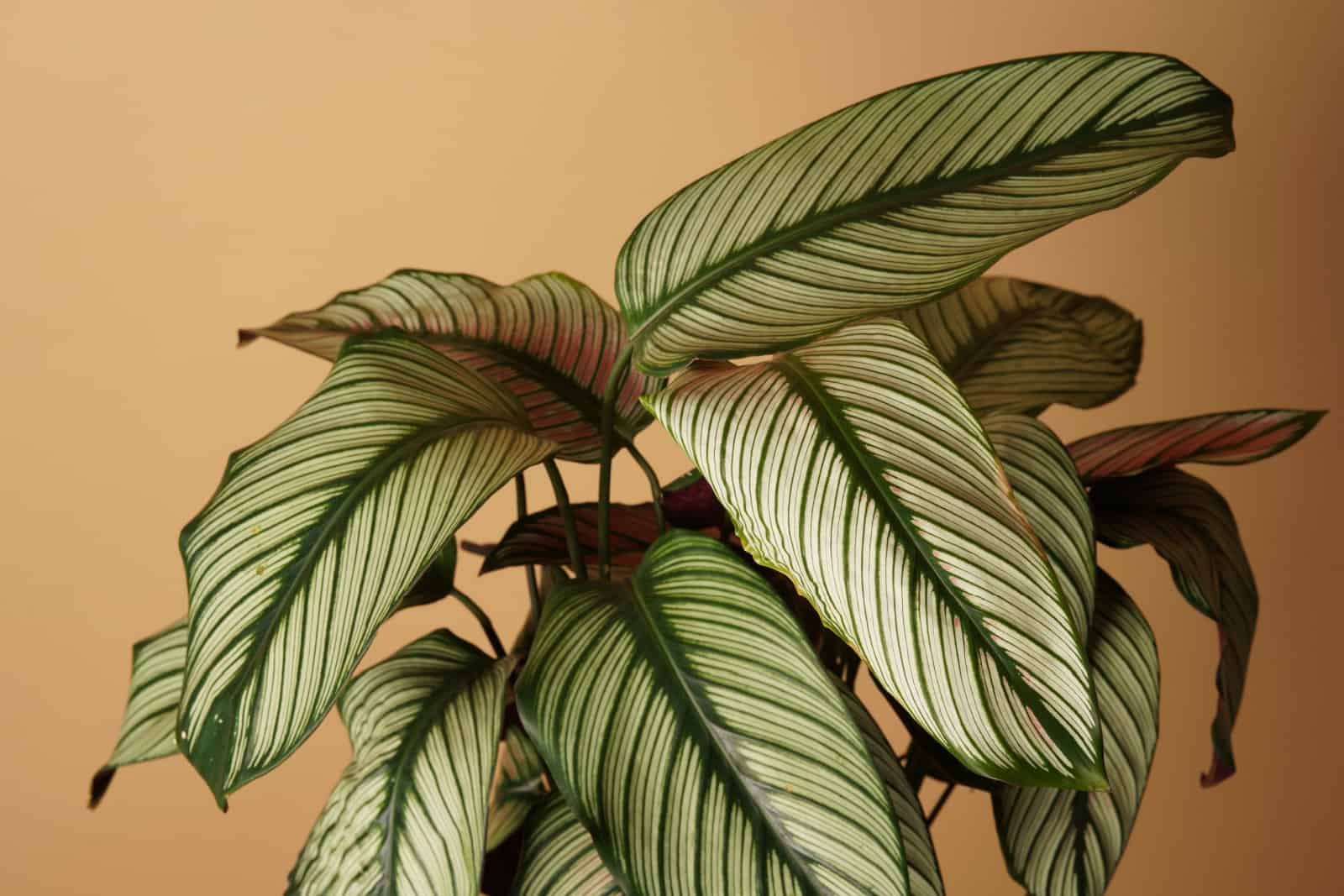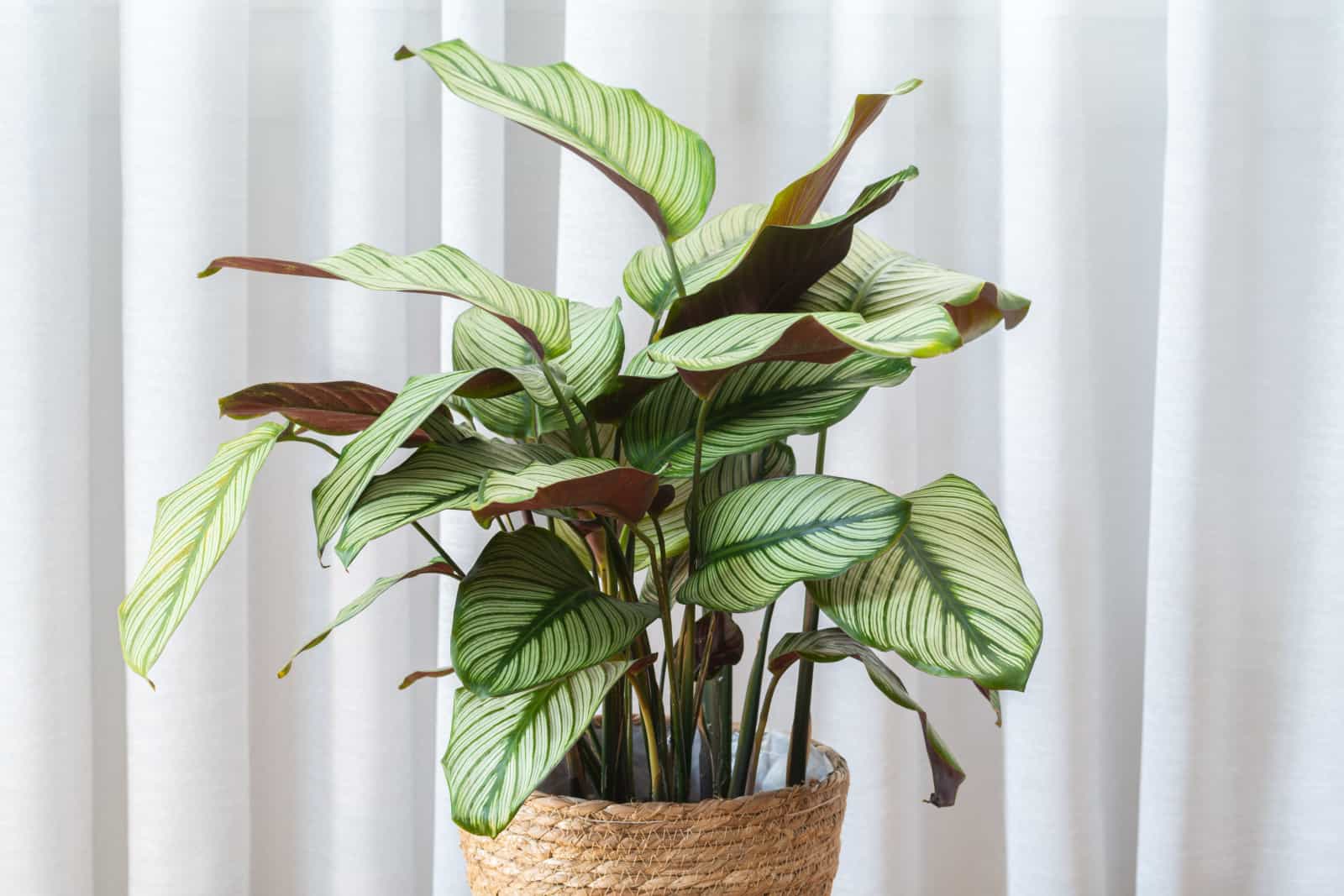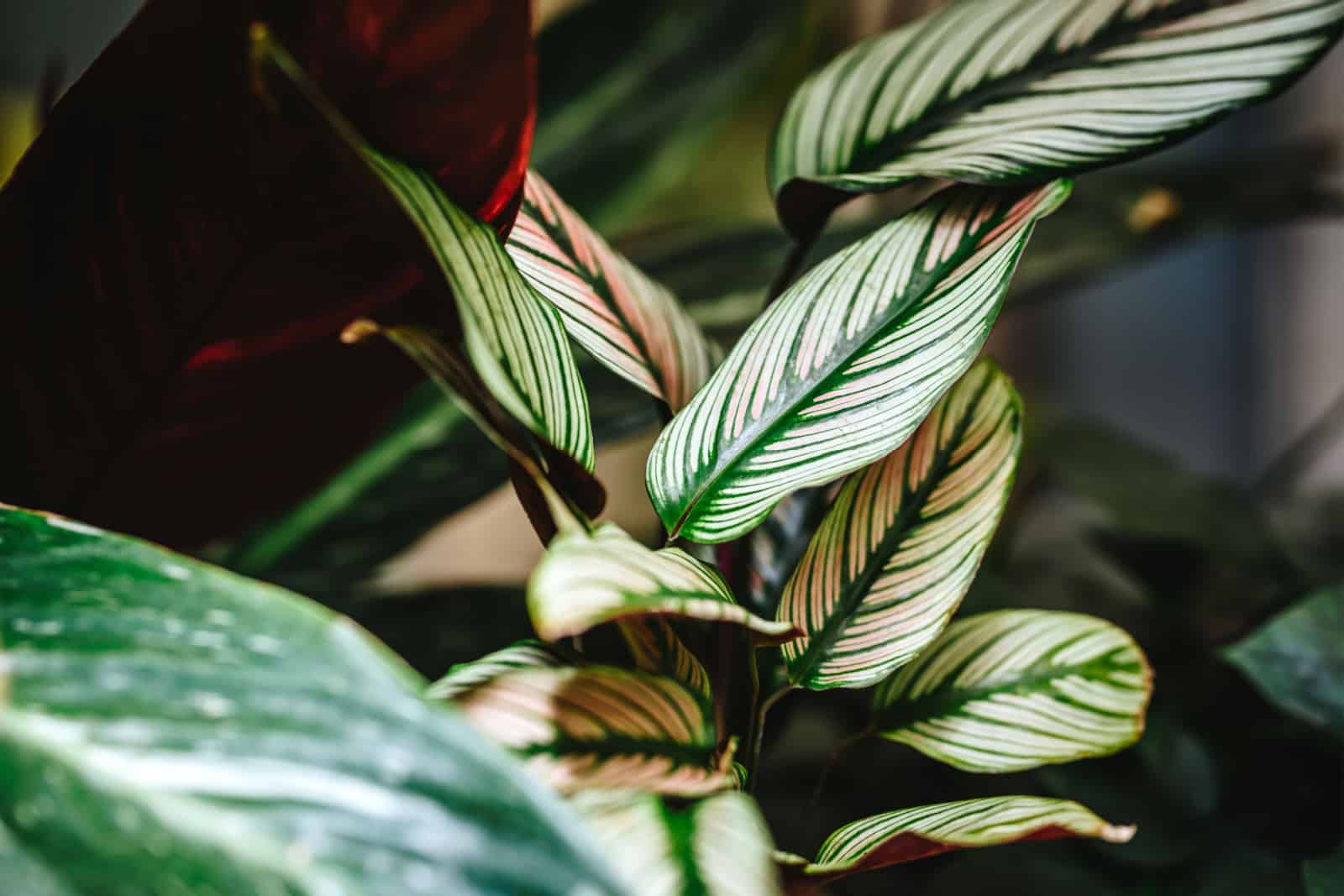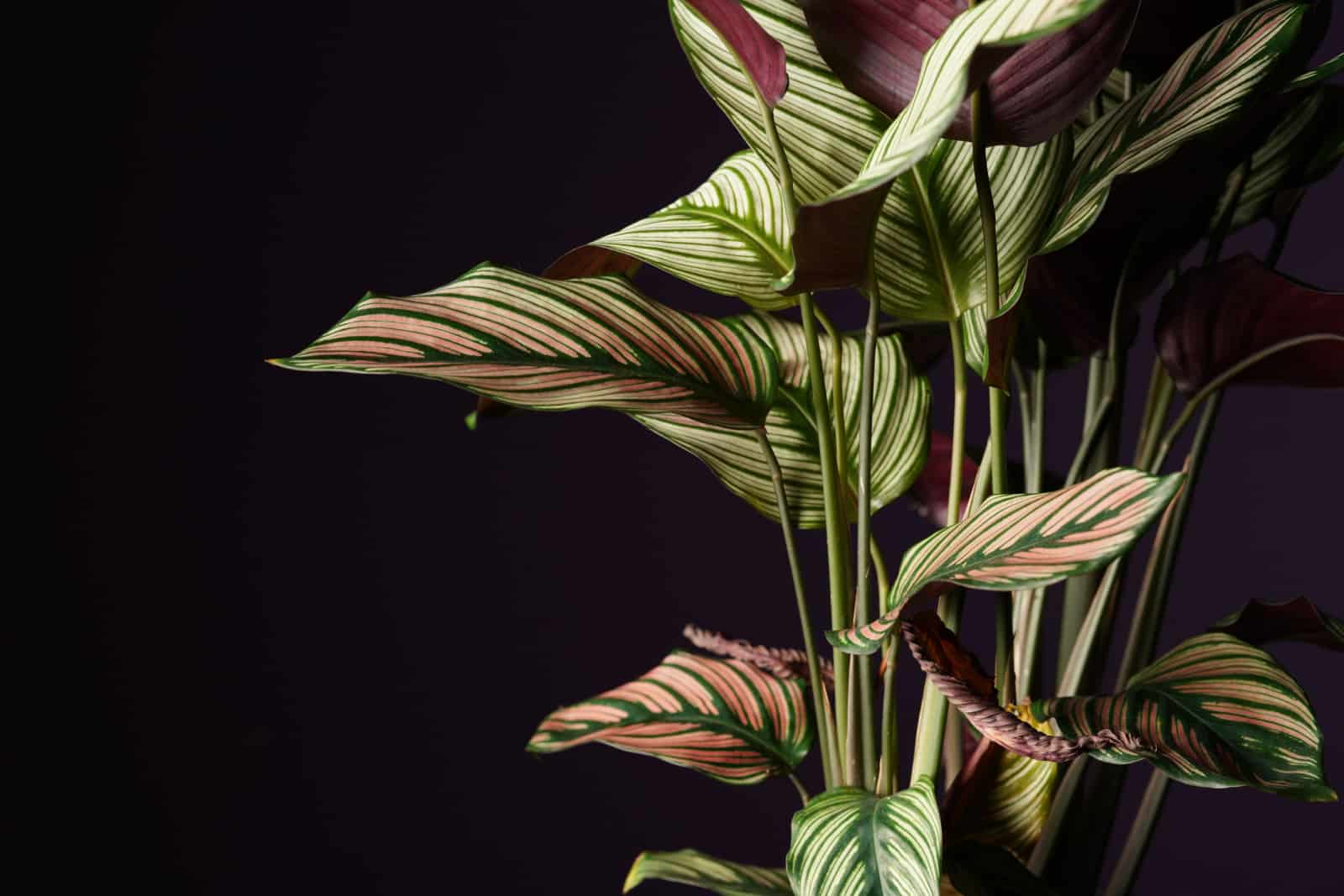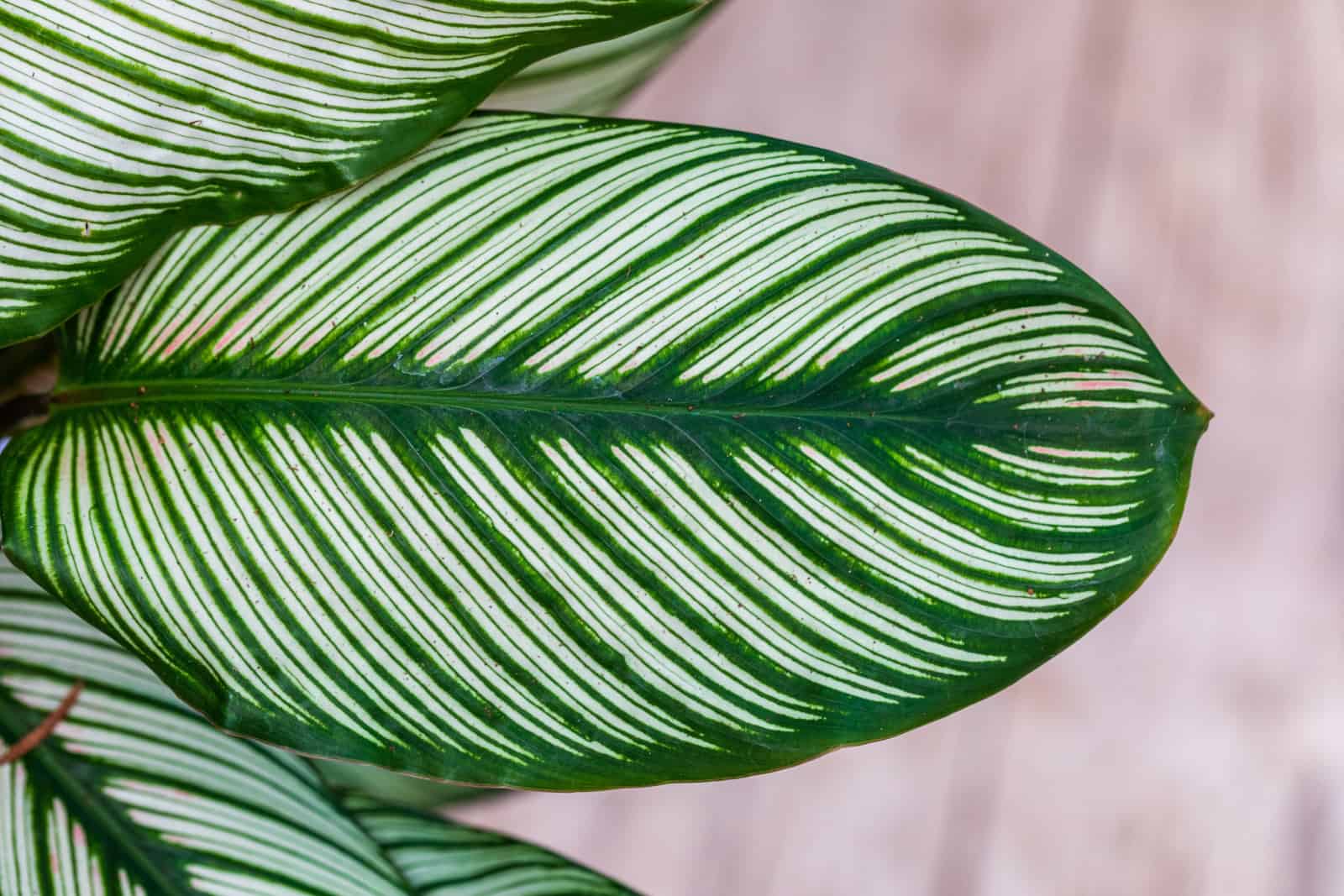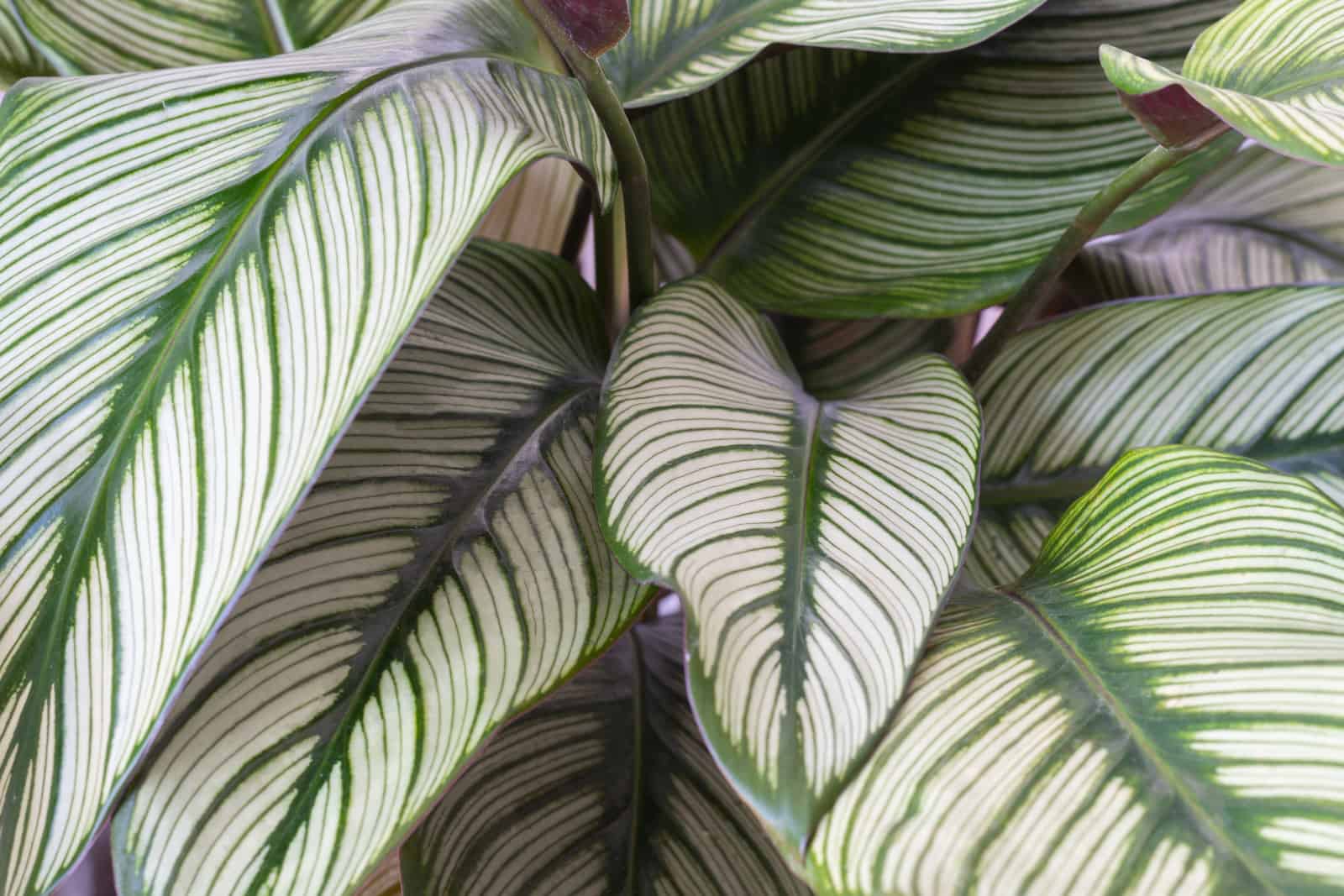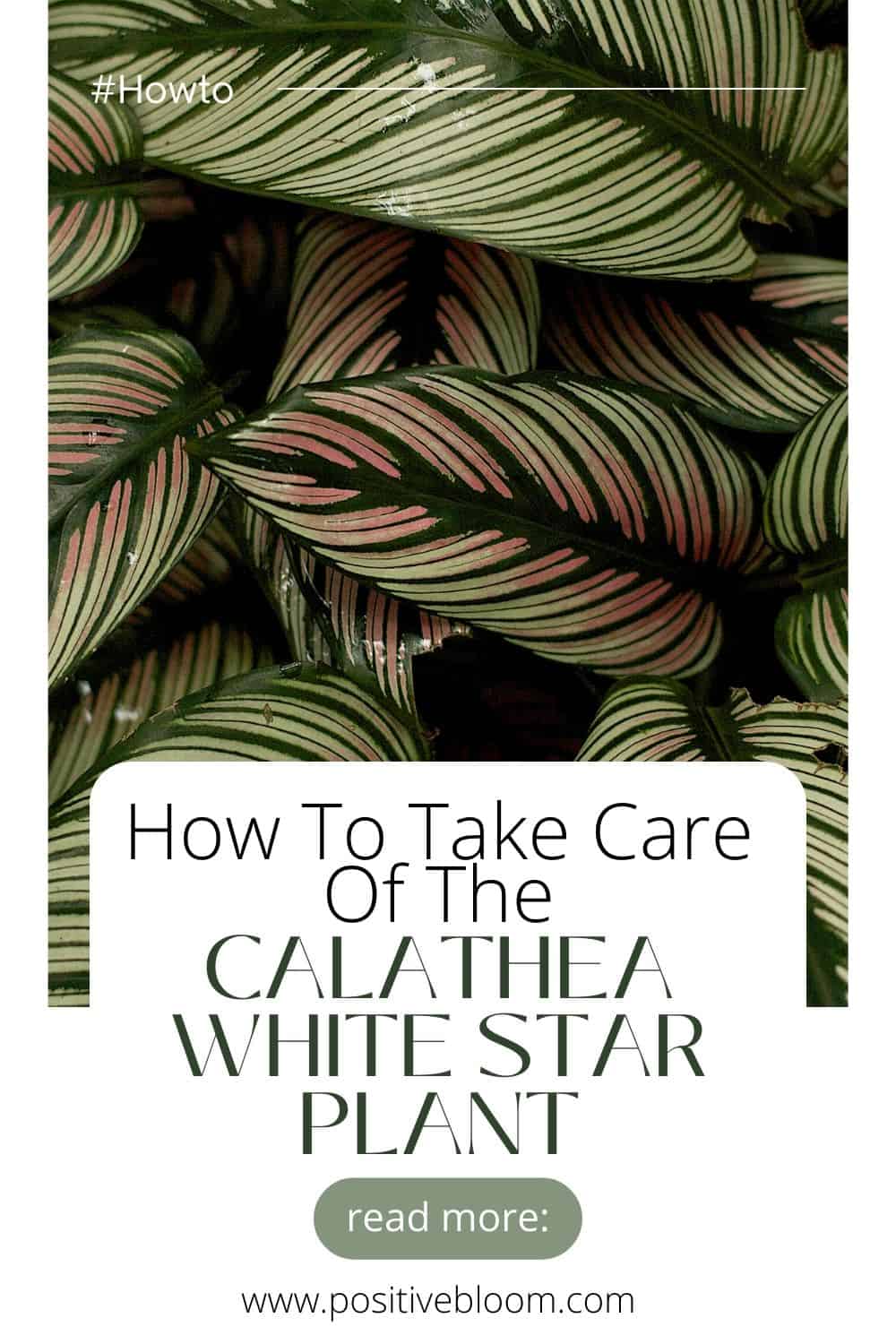Today we’re going to look at another lovely houseplant that comes from the deep rainforests of Brazil!
Calatheas are one of the easiest tropical plants to cultivate indoors, and there are so many different varieties that make any room look more lively. We are going to talk about the Calathea White Star, a lovely plant that has green, oval-shaped leaves covered with white stripes.
This plant truly looks like a piece of art, especially when it produces its magnificent pink and orange flowers!
Keep reading to find out more about this plant, and also how to take care of it.
Calathea White Star: Common Features
The Calathea White Star (common names: Calathea Majestica ‘White Star’, Calathea Majestic, Majestic Prayer plant, and Goeppertia Majestica) is a tropical plant that belongs to the Marantaceae family.
The flowing lines of the Pinstripe Calathea and the Rosy Calathea‘s light pastel combine to create the stunning Calathea White Star, which means that it is a rare Calathea Ornata species.
They are also called prayer plants due to the special movements of their leaves, which look like they are praying.
Origin
We have already mentioned that Calathea plants originated from deep Brazilian rainforests. It was originally discovered by Georg Meyer in 1822, and today it is one of growers’ favorite indoor plants all around the world.
Appearance
The Calathea White Star features dark green leaves that have an oval shape. These leaves are covered with condensed white stripes. They are quite similar to their other cousins, especially the Calathea Ornata; however, the White Star has more stripes that almost completely cover the leaves.
The plant simply exudes elegance and uniqueness!
In ideal growing conditions, it can even produce beautiful pink to orange flowers (though this happens rarely).
This plant is not toxic, and it is considered safe for both humans and pets.
Plant Size
The Calathea White Star can reach up to 5 feet tall, although you can prune it regularly if you want to keep it smaller. It also spreads around 2 feet wide, so make sure that it has enough space for proper growth and development.
It is not a fast grower — we can say that it has a moderate growth habit, so you won’t have to worry about repotting them every growing season.
Calathea White Star Plant Care Guide
When it comes to the Calathea White Star care guide, and the care guide for all prayer plants, you will notice that it is pretty straightforward. All you have to do is be extra careful when it comes to watering, as other requirements can fluctuate.
Let’s take a closer look!
Light Requirements
This plant doesn’t have very specific lighting needs, and it can easily adjust to various lighting conditions (anything moderate would be just fine).
The Calathea White Star prefers bright indirect light to partial shade in order to grow and thrive. Keep in mind that because these are tropical plants, they are constantly growing in shadow beneath large trees and other plants in their natural environments.
Due to the fact that many houseplants prefer bright or direct sunlight, this plant is excellent inside because of its adaptability to various light conditions.
In fact, you should keep this plant away from direct sunlight because its leaves might burn, which affects their appealing colors and patterns, and possibly results in crusty, brown leaves that are also curling.
I recommend you rotate your plant occasionally so that all of its parts can receive sufficient light.
Water Requirements
The most challenging step in caring for this plant is determining the right watering schedule. We are aware that Calatheas are tropical plants and that they are extremely thirsty; nonetheless, we cannot simply drench the soil in water without giving the plant a break. So yes, figuring out how much water your Calathea White Star needs might be challenging.
They want moist soil in general, but not soggy soil because this can cause root rot, which is followed by a variety of other problems. The best approach for you to decide on your watering plan is to allow the top of the soil to dry out completely before watering it again.
The type of water you are using must also be taken into account because these plants are extremely delicate and easily destroyed by substances and minerals found in tap water. For instance, if there is a lot of salt, fluoride, or chlorine present, the leaves may begin to turn brown.
To provide your plant with the greatest possible care, I would advise using filtered water or rainwater instead.
When watering, make sure to completely moisten the soil and avoid wetting the leaves because they can easily attract bugs and fungi that could harm your beloved plant.
Read also: What Is The Best Water For Plants? Find Out The Answer Here!
Soil Requirements
The prayer plant thrives in soil that is rich in organic matter, well-draining, and porous. There are commercial soil mixtures made specifically for Calatheas, but you can also create your own. I mixed one for my Calathea Roseopicta, and it’s growing really well! A solid foundation is the first thing you need. I usually start with standard potting soil and then add the necessary materials to enhance it.
When it comes to supplementing soil, you have many possibilities. Peat moss or charcoal materials, for instance, will aid in the soil’s ability to hold moisture.
On the other hand, materials like coco coir, pumice, perlite, and orchid bark will improve drainage.
For instance, you can create a fantastic potting mix for Calatheas by mixing potting soil (50%), charcoal (20%), orchid bark (20%), and perlite or pumice (10%).
Humidity Requirements
When it comes to humidity, this cultivar has quite specific requirements: it truly adores high humidity and needs humidity levels of at least 60%. What should you do if you reside somewhere with low humidity?
Humidity is not a problem that cannot be resolved if you are growing your plant indoors. Instead, there are several different things you can do to increase the humidity in your home.
The most effective approach is undoubtedly to get a humidifier. The least expensive alternative is to set a bowl of water close to the plant, but this is not as beneficial. You can also try misting your plant on a daily basis, but I often don’t recommend this as it can attract fungus.
You can also try and create a pebble tray — simply put some pebbles in a tray, cover them with water, and put your plant on top of it. As the water evaporates, it will provide the moisture that your Calathea plant needs.
You can put the plant in a humid room, such as the kitchen or bathroom. However, don’t put them in a low-light environment for too long.
Temperature Requirements
Despite the fact that some Calathea varieties may flourish in slightly lower temperatures, keep in mind that tropical regions are generally rather warm. As a result, Calatheas will prosper in temperatures ranging from 65 to 85 degrees Fahrenheit when cultivated indoors.
These plants shouldn’t be exposed to temperature fluctuations or any sudden temperature changes.
It may be difficult to keep your Calathea alive and healthy throughout the winter because excessive heat from heaters can severely harm it. This also holds true for air conditioners and chilly drafts.
Within USDA hardiness zones 10 and 11, this Calathea can flourish in the open air. Bring your loving plant indoors as soon as it falls below 60 degrees Fahrenheit.
If you don’t live in these areas, I would recommend you keep this plant indoors all year round.
Fertilizer Requirements
You won’t have to worry about fertilization since these plants are not relatively picky about it. You should use premium all-purpose houseplant fertilizer for this Calathea.
During the growing season, I advise feeding your Calathea once a month to promote new growth.
Since the foliage of this plant is what is grown most often, you should encourage the development of leaves by using nitrogen-rich fertilizers (though you might spot some blooms if the growing conditions are ideal).
Don’t apply fertilizers during the winter as these plants enter a dormant stage, which means that they won’t actively grow. Be careful not to overfertilize your plant as it can lead to salt and chemical buildup in the soil.
Pruning
The good news is that your lovely star plant doesn’t require too much pruning.
Use a clean pair of pruners to remove any diseased or discolored leaves to keep the plant looking nice and tidy, and also prevent the spread of disease.
You shouldn’t cut off the leaves if you see brown tips or margins on them, as your Calathea probably has another issue that you can swiftly fix to keep the leaves looking as wonderful as ever!
Repotting
Since they are regularly pruned, it is rare that a Calathea plant will need to be transplanted; nevertheless, if you miss one or two prunings, the roots may grow and require a larger pot.
You can easily repot your Calathea, so don’t worry!
The best time to do this is in the early spring before they start growing vigorously during the growing season. A day before repotting, give it a good soak with water to soften the soil and ease your work.
Purchase a larger pot with a drainage hole in the bottom, prepare the soil, carefully remove your plant from the pot without injuring the root ball, and that’s it! Your precious plant has been successfully replanted.
Propagation
Surprisingly, the Calathea White Star is not that difficult to propagate! They reproduce using rhizomes, which they use to spread and grow. Early spring or summer are the optimal seasons for propagation.
Make sure the mother plant is healthy before propagating it, otherwise you can experience stunted growth or no development at all. For successful propagation, follow the directions below:
1. Keep those little rhizomes in a warm, moist environment, and your new plant is going to thrive.
2. Create the proper soil conditions for this plant (this also applies to the pot).
3. Plant the rhizome and wrap a plastic sheet around the pot to keep the heat and moisture in.
4. Place your new plant in a dimly lit area to avoid damage from direct sunlight exposure.
Common Issues With The Calathea White Star
This indoor plant is relatively hardy. However, if you are not following the care tips mentioned above, your plant will most likely suffer from some disease or pest infestations. This is particularly important for plants grown outdoors, as it is hard to have full control of the growing conditions and the plant is more susceptible to pests.
Let’s look at the issues in more detail.
Pest Infestation
Spots beneath the foliage, spots on the leaves, discoloration, browning, and yellowing leaves could all be signs that your plant has been attacked by pesky bugs and insects.
Scales, spider mites, mealybugs, and fungus gnats are the pests that usually infest Calathea plants.
These tiny organisms can be difficult to spot, but if you look at your plant more closely, you might find several characteristics that are particular to distinct pest varieties.
For instance, if your plant develops any sticky substance on its stems or leaves, scales may be to blame since they secrete a sticky honeydew that attracts ants.
If the plant starts acting weirdly during the winter, then spider mites have likely visited it because they typically infest plants during the colder seasons. Higher humidity and leaf showers might prevent them from infesting.
Mealybugs tend to hide in leaves and steal the nutrients from your plant, so spots on the leaves are a sign that they are present. The best way to get rid of them would be with neem oil or insecticides.
Fungus gnats may appear out of nowhere and begin devouring the roots of your plant if the soil is perpetually soggy. If so, either let the soil dry naturally or apply a solution of water and hydrogen peroxide.
If you have issues with plant flies, then check out: How To Get Rid Of Plant Flies: 8 Effective Methods
Plant Diseases
Inadequate soil drainage and overwatering are common causes of root rot. Take prompt action to save your Calathea plant if the soil begins to smell bad because root rot is deadly.
The most typical symptoms of root rot include wilting, mushy soil, unpleasant odors, and yellow leaves with brown patches.
The best thing to do if your Calathea has root rot is repot it. Take it out of the contaminated soil, cut out the contaminated roots, and then repot it in a new container.
Once more, choose soil that drains properly and containers that have drainage holes.
Issues With Leaves
Those pretty leaves are what make this plant unique — so what should you do when they start wilting, curling, or losing their pattern?
The answer lies in plant care.
Let’s take a closer look.
Yellow Leaves
When the leaves begin to turn yellow, it happens quickly. You risk losing your cherished plant if you don’t act right away.
Yellow leaves are typically a sign of inadequate fertilization and watering, excessive exposure to sunlight, or natural shedding.
Overwatering is a major problem with this plant; make sure it has well-draining soil and a pot with drainage holes. If the leaves start to turn yellow, water the plant less and move it to a brighter location.
Fertilizing problems may result from excessive fertilizing (in this instance, flush the soil with distilled water), a deficiency in nutrients, or both. They do not require a lot of food, but you should still give them some fertilizers.
Natural leaf shedding depends on the plant’s temperament: if it has just been repotted, part of the leaves may turn yellow and fall off; otherwise, it may occur naturally as the plant grows and reabsorbs nutrients from lower leaves.
Brown Leaves
Low humidity levels may be the primary cause of the tips of Calathea leaves turning brown. There may also be other relevant causes, such as sunburn, overwatering, using tap water, and underwatering.
Your Calathea loves moist soil, as we have indicated in the care guide, but you should let the top inches of the soil dry out before watering. If you give it too much time without water, the edges of the leaves may turn brown.
You may have mastered the watering routine, but the tap water you use could be loaded with salts and minerals. Brown leaf tips might result from soil that contains a lot of salt. Instead, use distilled or filtered water.
This plant prefers indirect light, so keeping it exposed to full sun can lead to brown and crispy leaves.
Curling Leaves
Water stress may cause leaves to begin curling inward or outward, or the plant may simply become agitated and start acting out.
Underwatering may be the problem if the soil has fully dried out and you haven’t been watering your plant as frequently. Overwatering could be the problem if you have been watering your Calathea plant, but the leaves are curling and drooping.
If the latter is the problem, you should examine the plant for root rot; however, if the problem is underwatering, you should simply water more regularly and thoroughly.
Since there is no room for air movement, soil that’s too-compact could also be a problem. This can be readily fixed by poking tiny holes in the soil.
Pattern Loss
Inadequate lighting and nutrient deficiency are the main causes of leaves losing their distinctive patterns and becoming less variegated.
Moving your plant away from windows and into a room with less light will prevent the leaves from looking wilted or even translucent.
However, avoid going too low since this can also cause pattern loss. Your leaves may appear withered if there is not enough light. Insufficient nutrition can also be an issue, so buy your calathea some plant food as soon as possible.
Drooping Leaves
Due to the fact that they are prayer plants and they move differently during the night and day, meditative drooping may be expected during the daytime. If you see severe drooping, the problem may be insufficient watering, as in the case of curling leaves, or a temperature that is below optimal.
Keep in mind that because they are tropical plants, they are not used to low temperatures. Avoid placing them near drafty windows, especially in the winter, and keep them far away from the air conditioning in the summer.
To Sum Up
The Calathea White Star is definitely a superstar among tropical houseplants!
Not only does it produce magnificent flowers that can fit into any home decor (especially minimalist), but it also requires minimal plant care.
All you have to do is keep them nice and warm, make sure that their soil is moist and not soggy or bone dry, and give them some plant food during the growing season. Who knows, maybe you will be lucky enough to see these plants bloom!
But hey, don’t beat yourself up if they don’t produce any flowers — trust me, they do it rarely in nature too. Just enjoy the pretty foliage, and make sure to keep them away from direct sunlight.
I hope this article was helpful.
Until next time!
Like this post? Share or pin it for later!

